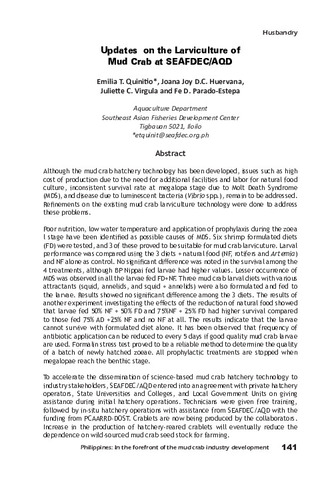Comparative transcriptome profiling of heat stress response of the mangrove crab Scylla serrata across sites of varying climate profiles

Associated URL
bmcgenomics.biomedcentral.comDate
2021Author
Page views
571Metadata
Show full item recordCited times in Scopus
Share
Abstract
Background: The fishery and aquaculture of the widely distributed mangrove crab Scylla serrata is a steadily growing, high-value, global industry. Climate change poses a risk to this industry as temperature elevations are expected to threaten the mangrove crab habitat and the supply of mangrove crab juveniles from the wild. It is therefore important to understand the genomic and molecular basis of how mangrove crab populations from sites with different climate profiles respond to heat stress. Towards this, we performed RNA-seq on the gill tissue of S. serrata individuals sampled from 3 sites (Cagayan, Bicol, and Bataan) in the Philippines, under normal and heat-stressed conditions. To compare the transcriptome expression profiles, we designed a 2-factor generalized linear model containing interaction terms, which allowed us to simultaneously analyze within-site response to heat-stress and across-site differences in the response.
Results: We present the first ever transcriptome assembly of S. serrata obtained from a data set containing 66 Gbases of cleaned RNA-seq reads. With lowly-expressed and short contigs excluded, the assembly contains roughly 17,000 genes with an N50 length of 2,366 bp. Our assembly contains many almost full-length transcripts – 5229 shrimp and 3049 fruit fly proteins have alignments that cover >80% of their sequence lengths to a contig. Differential expression analysis found population-specific differences in heat-stress response. Within-site analysis of heat-stress response showed 177, 755, and 221 differentially expressed (DE) genes in the Cagayan, Bataan, and Bicol group, respectively. Across-site analysis showed that between Cagayan and Bataan, there were 389 genes associated with 48 signaling and stress-response pathways, for which there was an effect of site in the response to heat; and between Cagayan and Bicol, there were 101 such genes affecting 8 pathways.
Conclusion: In light of previous work on climate profiling and on population genetics of marine species in the Philippines, our findings suggest that the variation in thermal response among populations might be derived from acclimatory plasticity due to pre-exposure to extreme temperature variations or from population structure shaped by connectivity which leads to adaptive genetic differences among populations.
Suggested Citation
Shrestha, A., Lilagan, C. A. I., Guiao, J. E. B., Romana-Eguia, M. R. R., & Ablan Lagman, M. C. (2021). Comparative transcriptome profiling of heat stress response of the mangrove crab Scylla serrata across sites of varying climate profiles. BMC Genomics , 22(1), 580. https://doi.org/10.1186/s12864-021-07891-w
Subject
Taxonomic term
Collections
- AQD Journal Articles [1246]
Except where otherwise noted, this item's license is described as Attribution 4.0 International (CC BY 4.0)
Related items
Showing items related by title, author, creator and subject.
-
Updates on the seed production of mud crab
Quinitio, Emilia T.; Parado-Estepa, Fe D.; Huervana, Joana Joy; Burlas, Michael Ray (Aquaculture Department, Southeast Asian Fisheries Development Center, 2015)Widespread interest in mud crab species is increasing because these are highly prized both in domestic and export markets. Among the three mud crab species commonly found in the Philippines, Scylla serrata, S. olivacea, ... -
Amino acid profiles in the midgut, ovary, developing eggs and zoea of the mud crab, Scylla serrata
Peñaflorida, Veronica Dy (Society of Israeli Aquaculture and Marine Biotechnology, 2004)Culture of the mud crab, Scylla serrata, is beset by low and inconsistent survival of larvae in spite of the high fecundity of crab breeders. The nutrition of the embryo and pre-feeding zoea depends on what is stored in ... -
Updates on the larviculture of mud crab at SEAFDEC/AQD
Quinitio, Emilia T.; Huervana, Joana Joy D. C.; Virgula, Juliette C.; Parado-Estepa, Fe D. (Aquaculture Department, Southeast Asian Fisheries Development Center, 2017)Although the mud crab (Scylla serrata) hatchery technology has been developed, issues such as high cost of production due to the need for additional facilities and labor for natural food culture, inconsistent survival rate ...




